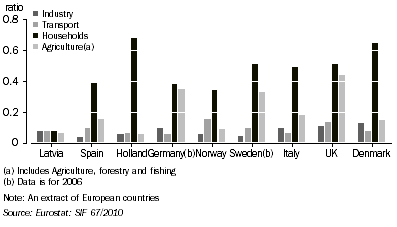EUROPE
In Europe, statistical offices are now obliged to report statistics on environmental taxes by industry and households to Eurostat(footnote 1) . A regulation was adopted in 2011 which referenced environmental accounts (EU Regulations 691/2011) and included the reporting of atmospheric emissions(footnote 2) and environmental taxes by industry and material flow accounts by products.
In 2009, the average tax revenue for environmental taxes for EU-27(footnote 3) was 2.4 per cent of GDP (Eurostat 67/2011).
In Europe, businesses and households share energy taxes paid (Figure 4.2). It should be noted however that in general, all European countries exempt the use of energy by industries in the production process from taxes.
4.2 Energy taxes per energy consumption by European country, Euros by tonne oil equivalents 2007

1 The statistical office of the European Union
<back
2 Such as GHG (CO
2, CH
4, N
2O, SF
6 and HFC), particulates (PM2,5 and PM10) acidic pollutants (SO
2, NH
3) and other pollutants such as CO, NOX, NMVOC and VOC
<back
3 Excluding Norway, Iceland, Switzerland, the Balkan countries and Turkey
<back
 Print Page
Print Page
 Print All
Print All